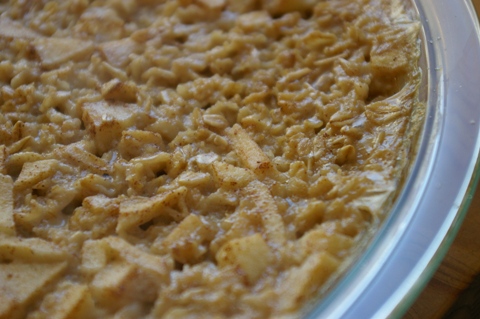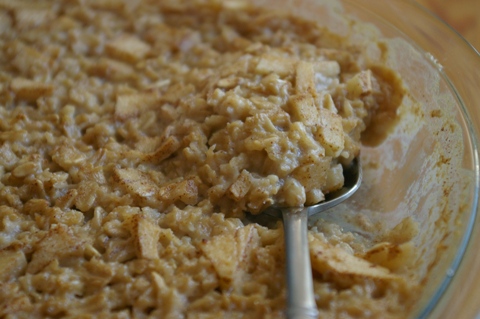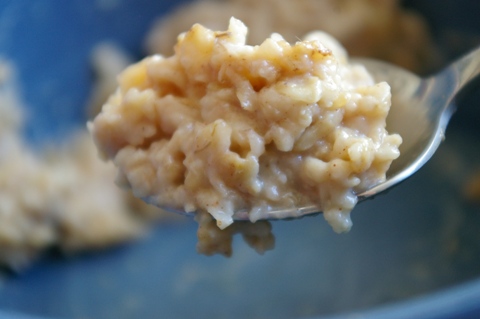
Sprawled horizontally on the couch, I started thinking about recipes that take little-to-no effort. Baked rice pudding instantly came to mind: I remember marvelling at how fantastically easy it was to make such a flavorful and luscious (and not all too unhealthy!) dessert. Inspired by the laziness of my rice pudding adventure, I decided to try the same technique with oatmeal. Granted, oatmeal doesn't require the stirring and monitoring that rice pudding does -- just zap it in the microwave and voila! you're good to go. But nuked oatmeal lacks the crust that I was so craving this morning (being without my bread and all.) Baking oatmeal would likely create a crisp exterior, which, when cracked, would yield soft, plump oats. And all it would involve was mixing everything together, transfering to a pan, and tossing in the oven. The whole thing sounded really promising. The result? Delicious, though I will say that I'd change a couple things the next time. And yes, dear readers, you will be privy to the lessons learned from my mistakes, so that you may make baked oatmeal perfectly the first go-round. Lucky you. :)
Lesson 1: a pinch of salt makes all the difference. Fortunately, I discovered this before serving, so I added a dash to each bowl and gave them a good mix before giving them to my eager taste-testers. It really is true that salt intensifies other flavors. Just a pinch helps balance the sugar and the creamy texture of the milk.
Lesson 2: A brulee-like top adds a dimension of luxury to an otherwise-rustic dish. This can be achieved in a variety of ways, not the least of which is sprinkling the finished product with sugar and crisping it with a torch. If you have a less-equipped kitchen, simply sprinkle sugar on top with three minutes remaining, turn the oven up to 400 degrees, and bake it off until the sugar has browned. This whole step, of course, is optional.
Lesson 3: Tart fruit are a key contrast to the sweet creaminess of the oatmeal. I used apples, but not enough; assume at least 2/3 cup of chopped tart fruit (peaches, plums, apples, and raisins are all excellent choices) for 1 cup of oats.
Now, without further ado....
Baked Oatmeal serves two, but easily doubled
- 1 cup oats
- 1 1/3 cups milk (I used 2%, but any sort will do)
- 2/3 cup water
- 1 tsp cinnamon
- a dash nutmeg
- 2/3 cup (at least) chopped tart fruit, such as apples, raisins, cherries, nectarines, plums, peaches, etc.
- 1/4 cup brown sugar, honey, or maple syrup
- pinch of salt
- Preheat the oven to 350 degrees.
- Mix all ingredients in a mixing bowl.
- Stir to combine. Make sure that sugar begins to dissolve.
- Lightly spray a shallow baking dish (I used an 8" casserole, but any old dish will do.)
- Pour mixture into dish, and transfer to oven.
- Bake 40 minutes, or until all most liquid has evaporated.
- If desired, sprinkle with sugar when oatmeal is nearly finished, crank the oven to 400, and bake off until sugar has browned.
- Add more milk to serve, if desired.
-

